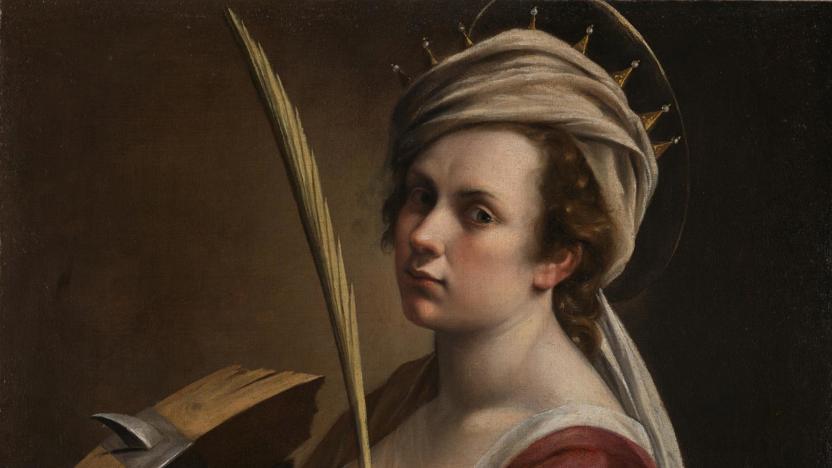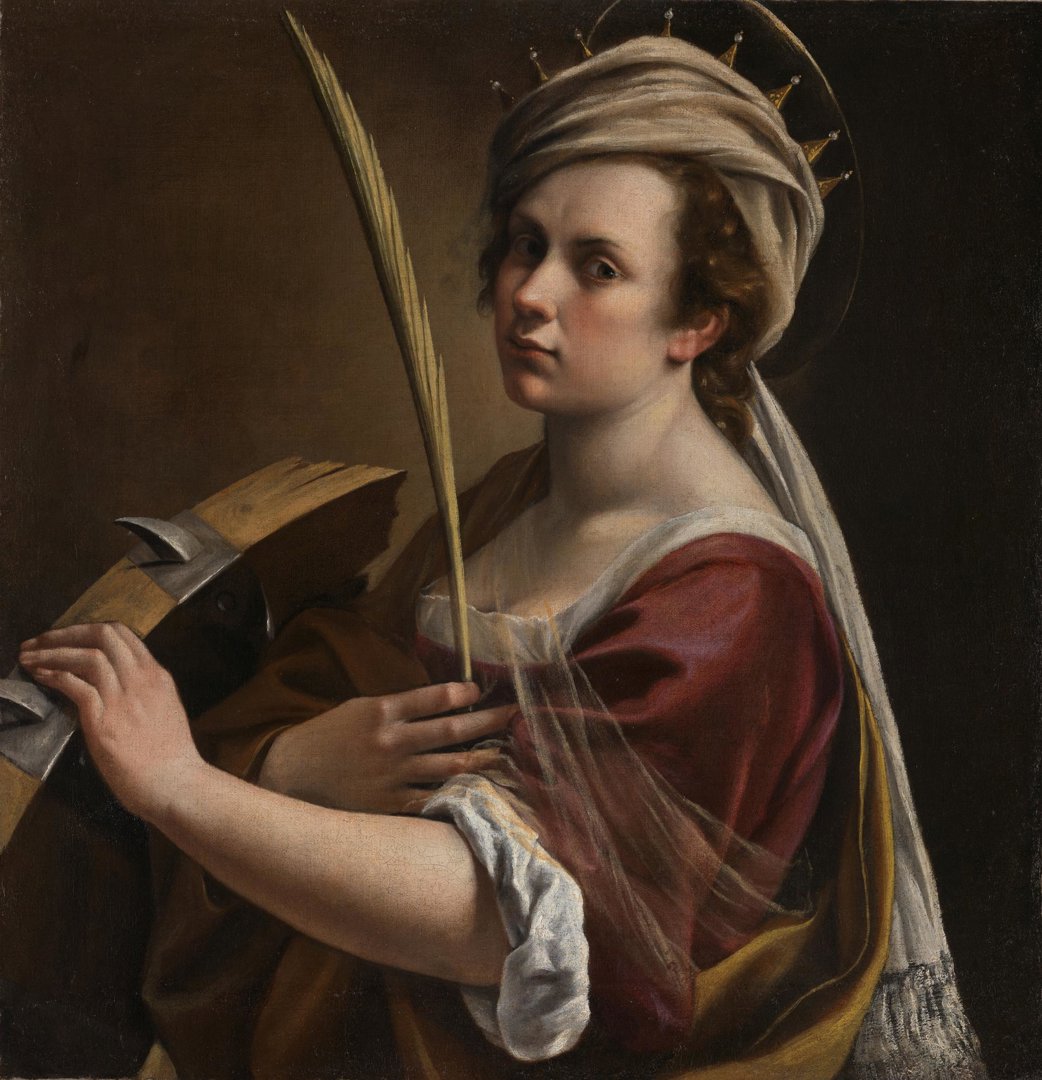Artemisia Gentileschi's 'Self Portrait as Saint Catherine of Alexandria'
Audio description
This is an Audio Description of Self Portrait as Saint Catherine of Alexandria by Artemisia Gentileschi, it will take about eight minutes to listen to.
Artemisia Gentileschi is one of the most celebrated artists of the 17th century. She worked in Rome, Florence, Venice, Naples and London, and counted some of the leading European rulers of her time among her patrons. She was born in Rome in 1593, the daughter of Orazio Gentileschi - a famous painter and contemporary of Caravaggio. This accomplished oil painting is a realistic self-portrait of Artemisia in the guise of Saint Catherine of Alexandria. It was painted between 1615 and 1617 in Florence, where the artist created a number of self-portraits based on biblical figures.
Catherine was a Christian saint, martyred in the early 4th century. In the painting, the artist holds a martyr’s palm leaf in her right hand and leans against a broken, wooden wheel studded with iron spikes. The wheel was an instrument of torture used in public executions, and Saint Catherine was harnessed to one and condemned to death. According to legend, she was rescued by divine intervention, and the wheel became her symbol or attribute. Artemisia has deliberately chosen to use her own likeness for Saint Catherine whose strength and resolve, having withstood her torture, is evident.
The painting is contained within a tight square of approximately 70 cm. It depicts Artemisia from the waist to just above head height. This close cropping adds to the intensity of the composition. The artist gazes directly out at the viewer, with what The National Gallery curator Letizia Treves describes, as ‘resilience and quiet determination’.
Artemisia stands in the centre of the image against a sombre background of dark brown, which lightens to the left of the figure. She is dressed in a generous, deep red gown, with a heavy golden wrap draped over her right shoulder and wound about her waist. She is turned aside, her body facing the wheel on her right. It reaches up to shoulder height and is broken at the far end with jagged fissures in the wood. Due to the cropping of the composition, only the top part of the wheel is shown. This section has two sharp metal spikes. They are attached to strips of metal that are nailed to the inside of the wheel. The spikes are shaped like fat claws that face away from her. In the foreground, at the bottom of the painting, the artist reaches her left arm across to lightly support the wheel just above the front spike. Her thumb is hidden, tucked away in the shadows beneath the wheel. Her little finger brushes the side of the spike and her knuckles are rosy pink. Her right arm is pulled in tightly between the inside of the wheel and her chest. The back of her hand is turned outwards as she delicately holds the palm frond between thumb and forefinger, like a quill. Her other fingers are splayed against her bodice, her little finger obscured by her other sleeve. The palm leaf is a muted yellow and shaped like a long, narrow feather. It arcs away from Artemisia, its tip just inside the top edge of the frame. Her dark red dress is of a luxurious material with a deep sheen. It has a square neckline with a white collar and generous white cuffs which are loosely rolled back at her elbow. The collar has a narrow white frill at the front but is cut low enough to reveal the swell of her breast. A sheer scarf hangs from her right shoulder and sweeps across her décolletage, over her left arm.
Artemisia has pale, luminous skin. She gazes out through strong, hazel eyes under slim, dark, arching eyebrows. Her attractive face has soft, rounded features: a pert nose, a dimpled chin. Her shapely lips are pursed. Her cheeks are flushed. As she is turned aside, her left cheek and the left side of her neck are exposed: her left ear carefully delineated with shallow pink creases. On her head she wears a long, off-white scarf wrapped like a turban. The end of the scarf hangs down her back. Its silky fringe reaching the bottom edge of the painting. The turban is angled to reveal her full, pale forehead. At the sides, her chestnut curls are tucked back under the turban and gathered at the nape of her neck. Several wispy curls escape from the confines of the turban to cloud the edges of her cheeks. Protruding from the top of the turban are the radiating slender points of a gold crown. The crown has eight triangular points that each pierce a single glowing pearl. The highest pearl is just enclosed within the painting. Encircling the top of her head is a shimmering halo, most of which is visible within the frame.
The scene is depicted theatrically, lit from a source above. This illuminates the top of the wheel, the modelling of Artemisia’s outstretched arm and the smooth gleaming skin of her neck. To the rear of the figure is an inky darkness, which lightens to the figure’s right. The contrast with her lightly-toned turban, and skin, has the effect of offsetting her face. The inside of the wheel is in shadow as are the creases in the deep folds of her garments. The painting is enclosed within a 17th-century Tuscan frame that is about 20 cm wide. The frame is black with gold-painted borders and painted decorative patterns at the four corners, with delicate gold flower motifs in between.
The painting dates from Artemisia’s period of activity in Florence, where she moved from Rome in 1612, following her rape by Agostino an acquaintance of her father. During the infamous trial that ensued Artemisia testified and was subjected to physical torture. Tassi was convicted (though his banishment from Rome was never enforced). Following the trial Artemisia married and moved to Florence, where she established herself as an independent artist, becoming the first woman to gain membership to the Academy of the Arts of Drawing. Artemisia used her own image frequently in her works which may have been a conscious act of self-assertion. She became highly regarded and by the time she returned to Rome in 1620 her paintings were in great demand. In 1630 Artemisia settled in Naples where she ran a studio together with her daughter Prudenzia and continued to enjoy considerable success. She briefly visited London in 1639, possibly to assist her father on a series of ceiling paintings for the Queen’s House at Greenwich - which are now installed at Marlborough House in London – but she returned to Naples the following year. The precise date of her death is not known.
Some of her paintings have been read in biographical terms, especially scenes featuring a strong female heroine. Her most famous work Judith Beheading Holofernes has been interpreted as her pictorial revenge on Tassi. Though it is debatable whether such works were specifically produced as creative responses to her assault, there is no question that Artemisia’s personal identity is closely intertwined with her art. Artemisia was admired during her lifetime but was forgotten over the following centuries and has only been duly re-evaluated over the last fifty years.


